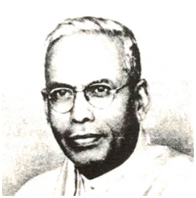I’ve mentioned Ranganathan briefly in some earlier posts. Let’s look at his innovations and influence from a historical perspective.
Shiyali Ramamrita Ranganathan (1892-1972) was an Indian mathematician and librarian. His academic training was in mathematics, in which subject he earned two degrees. He taught mathematics and wrote several articles on the history of mathematics. These articles worked to his advantage when the University of Madras was seeking someone with a research background to fill the post of University Librarian. Ranganathan applied because the job paid better than his professorship at the same university.
And what about Ranganathan’s background in librarianship? Well, a few days before the interview, he had read up on the subject in the Encyclopædia Britannica.
He got the job, but he found that it didn’t offer much intellectual stimulation or professional interaction with students and colleagues. In short, he was bored stiff. So he asked for his prior position as a math professor back. The position was held for him until he returned from his training in modern librarianship at the University College London. He would be allowed to choose which position to stay with after returning from his librarianship studies. After nine months of study in London, Ranganathan received an honors certificate from the University College. His mathematical training gave him a unique perspective on the problems of classification and other library matters, and he returned to his library position eager to put his ideas into practice.
During his time in England, Ranganathan visited over 100 libraries to observe their operation. His observations of both their shortcomings and the overall superiority of their methods over those of India led him to develop some egalitarian principles, published in 1931 as The Five Laws of Library Science. The five laws are as follows:
1) Books are for use.
2) Every reader his book.
3) Every book its reader.
4) Save the time of the reader.
5) A library is a growing organism.
In the five laws, we can see Ranganathan’s interest in access to information for everyone. This interest dovetailed with his work in classification science. He perceived that existing classification systems were not entirely suited for accommodating new areas of knowledge. He knew that a new, flexible approach was needed.
What happened next (well, actually, in 1924), as described by noted information scientist Eugene Garfield in his first essay on Ranganathan, was pure inspiration:
“As so often happens in scientific discovery, this vague notion was fully conceptualized only with the help of an unlikely catalyst. For Isaac Newton, according to legend, the catalyst was a falling apple. For Friedrich Kekulé, discoverer of the benzene ring, it was a snake with a tail in its mouth that appeared to him in a dream. For Ranganathan, it was a toy erector set at Selfridge’s, the London department store. There he saw a salesperson create an entirely new toy with each new combination of metal strips, nuts, and bolts. This experience made Ranganathan realize that his classification scheme should likewise consist of elements that could be freely combined to meet the needs of each specific subject.”*
As it happened, the classification system that Ranganathan devised, known as Colon Classification, was never widely adopted. However, the theory behind it had enormous impact on classification and indexing science. According to Garfield, in his second essay on the famed librarian, “Ranganathan is to library science what Einstein is to physics.”**
Thanks, in part, to Meccano toys, Ranganathan is widely regarded these days as the father of library science.
Marjorie M.K. Hlava, President Access Innovations
Note: The above posting is one of a series based on a presentation, The Theory of Knowledge, given at the Data Harmony Users Group meeting in February of 2011. The presentation covered the theory of knowledge as it relates to search and taxonomies.
*Eugene Garfield. “A Tribute to S.R. Ranganathan, the Father of Indian Library Science. Part 1. Life and Works,” Current Contents No. 6, pp. 5-12 (February 6, 1984). Reprinted in Essays of an Information Scientist, Volume 7. Philadelphia: ISI Press, pp. 37-44 (1985).
**Eugene Garfield. “A Tribute to S.R. Ranganathan, the Father Library Science. Part 2. Contribution to Indian and International Library Science,” Current Contents No. 7, pp. 3-7 (February 13, 1984). Reprinted in Essays of an Information Scientist, Volume 7. Philadelphia: ISI Press, pp. 45-49 (1985).










This is true fact that He was a genius person and contributed his life towards Library Science advancement.And his laws is relevant to this “Data-age”. I want to get it know more that Colon classification could be applicable to knowledge representation from muti-location data having different properties ,when user search on this digital library. And can user assign tag for their selected information.